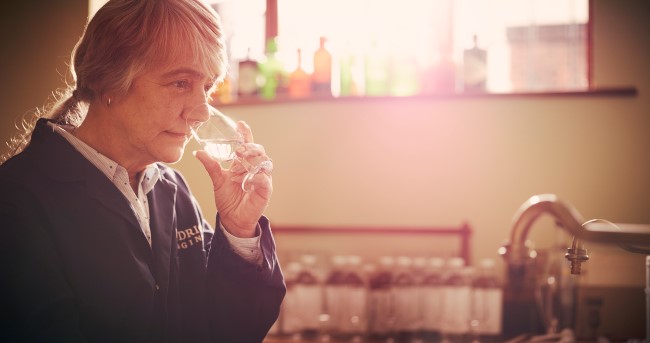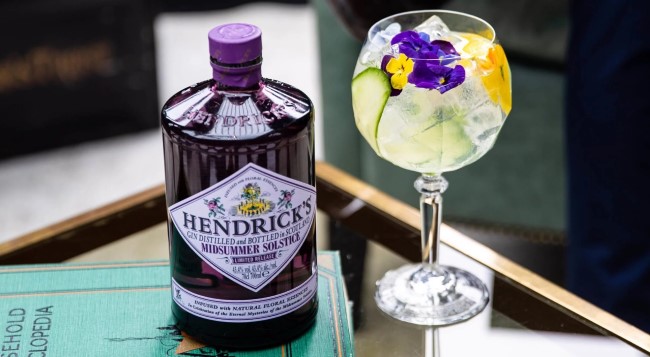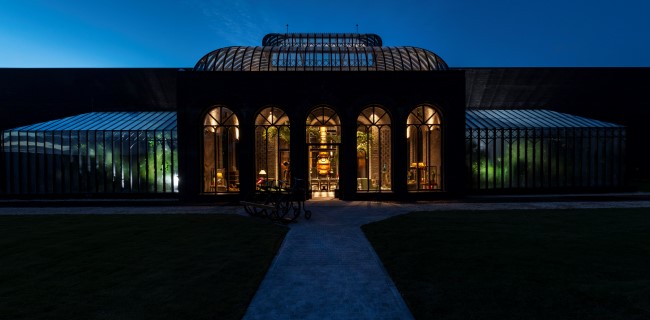Hendrick’s New “Gin Palace” Is a Temple to the Ethereal Joys of Flavor Experimentation
Photos via Hendrick's Gin, Jim Vorel
For almost two decades after the creation of Hendrick’s Gin in 1999, every drop of the brand’s award-winning gin was distilled in what was essentially a small, red brick shed.
It wasn’t a particularly inspiring sight, at least from the outside. A bombproof building on the site of a former munitions factory, which by and large had been turned into a distilling operation for the grain whiskies of William Grant & Sons, Hendrick’s always stood aesthetically apart from the rest of the operation. Although nestled in the picturesque Scottish hills of seaside Girvan, Scotland, flush with sheep and carefully laid stone fences, the actual distillery was fairly cramped and economical. Employees, including Hendrick’s Master Distiller Lesley Gracie, sarcastically referred to the idiosyncratic building as the “gin palace,” in honor of its unassuming nature.
Two decades later, though, the term “gin palace” is no longer an inside joke. Now it’s a glistening showroom; a temple built in honor of gin’s delicate loveliness. What was once a punchline has become the brand’s most impressive asset. Aside from Gracie herself, that is—the palace’s regal matriarch.
The new Gin Palace, first unveiled to select friends of the brand in 2018, sits only 50 meters or so away from that original brick shed. The bombproof nature of the original building having made expansion impossible, William Grant & Sons decided upon a massive investment in Hendrick’s future. They knocked down a whisky warehouse, creating a blank patch of land that was destined to become a statement piece for Hendrick’s as a brand—an ornate Victorian greenhouse, ensconced in tiny hills of flowing grass, that also houses a greatly expanded distilling operation. One gets a sense that much of the building’s design was conceived in honor of Master Distiller Gracie’s contributions—an acknowledgement of everything she’s meant to the brand over more than 30 years of service. Here, the brand would create a playground for Gracie’s imagination to run wild.

And indeed, following my return from visiting the Gin Palace at Hendrick’s invitation, I’d hope you could forgive some immediate Willy Wonka comparisons, in terms of the imagination on display, as the place is frankly fantastical to see. Upon entry, a high-ceilinged reception room is flanked by dual hothouses—one tropical in climate, one Mediterranean—where everything from mango and orchids to grapefruit and yuzu can be grown for flavor experimentation. On the second level, a miniature lecture theater bids guests aperire animo in a sign above its entrance: “Open your mind.” Down the hall, a lushly appointed lounge and bar showcase old gin bottles from William Grant & Sons past—and curious oddities like a 6 liter jug of Hendrick’s, or a leather guitar case made to hold an entire set of Hendrick’s cocktail paraphernalia in what might be the world’s most unexpected source of a G&T. Everywhere you look within the Gin Palace, there’s another source of curiosity. And that’s before you even get into the distillery proper.
Certainly, it’s a changed landscape from when Lesley Gracie first arrived as an employee of William Grant & Sons in 1988. Calling herself “not much of a spirits drinker” at the time, she hailed from a background in analytical chemistry, with a pretty unique area of focus: Flavor itself. Having previously applied her skills in the pharmaceutical industry, the distilling company realized her unique skill set could be used to “fingerprint” the flavors in their products on a more concrete, analytical level. And from there, it was only a matter of time until she was tasked with creating new flavor profiles from scratch. That license to create first gave us Hendrick’s Gin in 1999.
“The gins present at that time were mainly classic London drys, quite light and dominated by juniper,” says Gracie, surrounded by scientific implements in her personal lab within the Gin Palace. “The cocktail culture hadn’t picked up yet either, so it was mostly just gin & tonic, or gin & bitter lemon, things like that. That’s how people were consuming gin. I feel like when Hendrick’s came along, it sort of picked up the category and shook it by its neck. I think just the uniqueness of its flavors, and the ability to do different things with it, allowed bartenders to play more and expand their perception of how they could use gin.”

The classical Hendrick’s profile, or the “Hendrick’s house style,” as Gracie now refers to it, certainly stood out sharply from its competition at the time, both in flavor and in presentation—no gin bottle on the rack looked anything like the short, squat, black bottle of Hendrick’s, which immediately helped set it apart. In terms of flavor, Gracie was asked to both celebrate the U.K. and deviate from the expected, something she accomplished by choosing to highlight two classical symbols of England that hadn’t seen use before as gin botanicals: Rose and cucumber. The flavors of both are impossible to capture via traditional steam/hot water distillation, which meant another innovation in the form of vacuum distillation to capture the delicate essences of both. Now, the duo of “rose and cucumber” find themselves synonymous with Hendrick’s as a result, being captured in illustrations and stained glass all throughout the facility.
 Ever see a stained glass cucumber?
Ever see a stained glass cucumber?
-

-

-

-

-

-

-

-

-

-

-

-

-

-

-

-

-

-

-

-

-

-

-

-

-

-

-

-

-

-

-

-

-

-

-

-

-

-

-

-










































